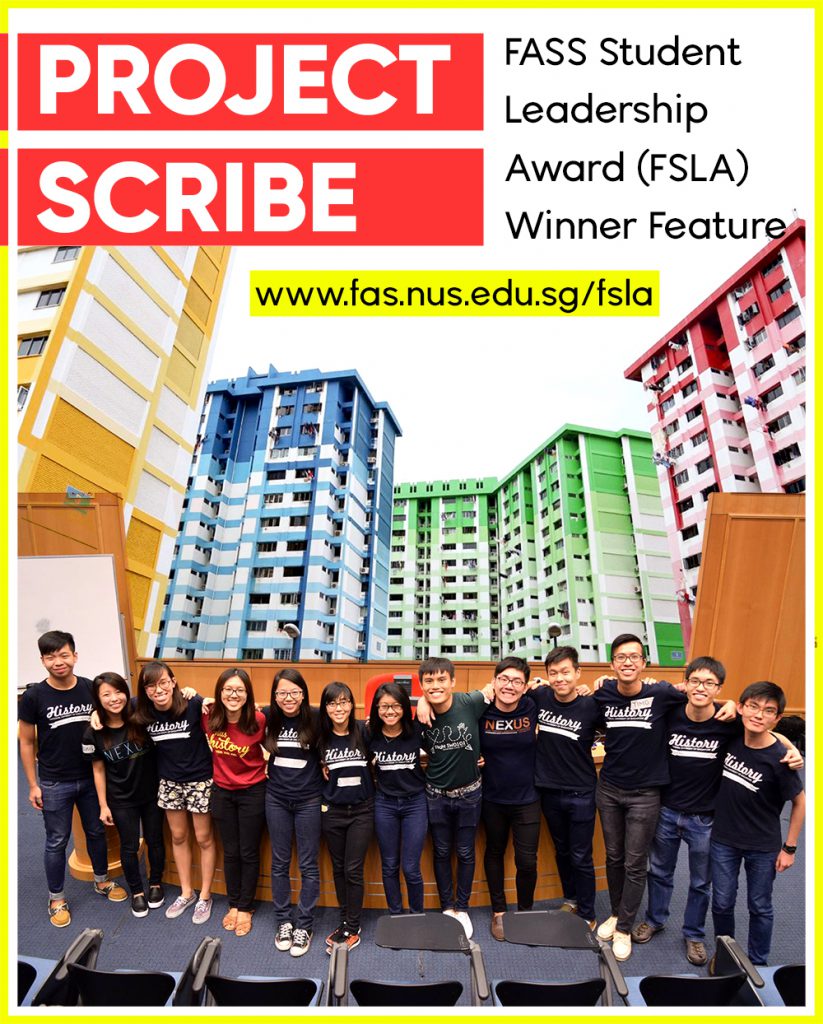FSLA 2017 | Group Award: Project Scribe, Remembering Rochor

When it was announced in 2016 that Rochor Centre was to be demolished to make way for the construction of the North-South Expressway, the team behind Project Scribe: Remembering Rochor quickly sprang into action. They had two main goals: one, to equip secondary school students with basic research skills in the humanities; and two, to document the history of Rochor Centre, one of the first few estates in Singapore that integrated residential and commercial usage under one roof, so as to ensure that the legacy of the four rainbow-colored blocks remains in a society that prides itself on change and transformation.
Over four months, Project Scribe matched thirteen teams of secondary school students with undergraduate mentors from NUS, who guided the former on the basics of first-hand research and imparted the necessary know-how to interview the residents and tenants of Rochor Centre. As the 81 secondary school students immersed themselves in research and archival work, they grew to realise that history is happening right now beneath their feet, in the process developing a greater appreciation of the discipline beyond textbook knowledge. Project Scribe concluded its run four months later with short presentations from the respective teams, which further impressed on the students the power of oral history.
We speak to the Project Directors, Lim Natasha Ann (N) and Lim Jia Yi (J), then-President of History Society (HISSOC), Timotty Tay Jun Jie (T), and Vice-President, Low Hui Min Clarissa (C) to find out more about Project Scribe. The four were quick to highlight that Project Scribe would not have been possible without the help of volunteer mentors and students across NUS, whose extensive contributions ensured the success of the project.
Enjoy the interview below!
1) Could you tell us about Project Scribe: Remembering Rochor and your motivations for initiating it?
N: Project Scribe is an oral history project that NUS HISSOC undertook after its first run. As many of us would like to develop a greater interest in History among youth, this project aimed to expose students to different methods of obtaining sources to provide alternative voices to Singapore’s history.
J: NUS History Society were not the pioneers in Project Scribe. We first heard about this project from two of our seniors, Nadjad and Darrell, who ran this programme in the University Scholars Programme (USP) and were looking for people to sustain this endeavour.
C: HISSOC then assembled a team together and thought about using this programme to capture the memories of the residents in Rochor Centre, which was about to be demolished at that time in 2016.
2) What was the impact of your project?
N: Our project reached out to over 50 students from seven different schools, and we produced a booklet for some residents of Rochor Centre to capture their fond memories of the neighbourhood.
T: To equip the secondary school students who would be unfamiliar with oral history methods, we also ran a one-day workshop that educated them on the historical method and how historians utilize primary sources to craft narratives and to learn to use the recording devices that we have loaned from the Faculty.
J: We also had NUS student volunteers who mentored them in writing these narratives over a period of three months. Some of our peers were not even History majors, let alone part of HISSOC officially, and we are glad to have met them along the way. Also, our juniors from the Society also took the programme up for the 2017 iteration.
3) What challenges did your group face while working on it and what motivated you to keep going?
N: We faced some difficulties obtaining funds, and had to seek support from the National Heritage Board (NHB) under the SG50 project applications.
T: We also sought funding from the Lifelong Learning Institute. We also found it difficult to work with a Residents' Committee that was technically non-existent, as residents were already beginning to move out of the premises when we began the project.
C: We came across quite a lot of obstacles along the way. Funding was definitely a huge issue. We learnt that there were numerous criteria to meet if we even want to apply for any sort of funding from FASS, or even do any sort of event in FASS.
4) Are there any recent developments or updates to your project?
C: HISSOC carried out a second round of Project Scribe in 2017, focusing on the memories of residents living in Tiong Bahru.
5) Are there any other projects you have worked/are working on?
T: Yeah, the project of growing up after graduating I guess.
6) What are your fondest memories of NUS?
N: The Yong Tau Foo stall in FASS. Definitely.
T: It was a pretty transient but carefree time in hindsight. I vaguely remember the strangest of conversations from the most random of people at various points of my four years there. My memory is failing.
7) What have you all been up to since you graduated from NUS?
T: Three of us are busy molding the future of our nation, so we are still hopeful about impacting youth in the future. Jia Yi is continuing her journey in higher education in Waseda, Japan, busy with her thesis.

